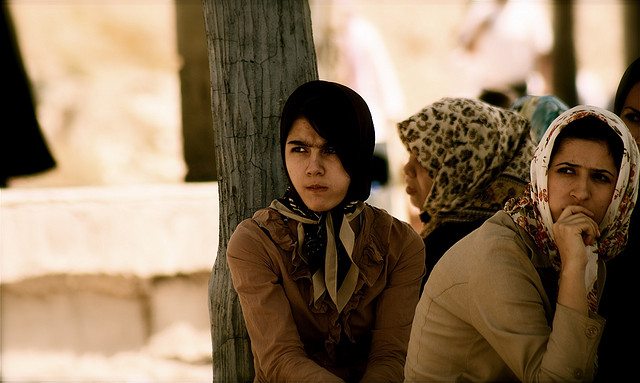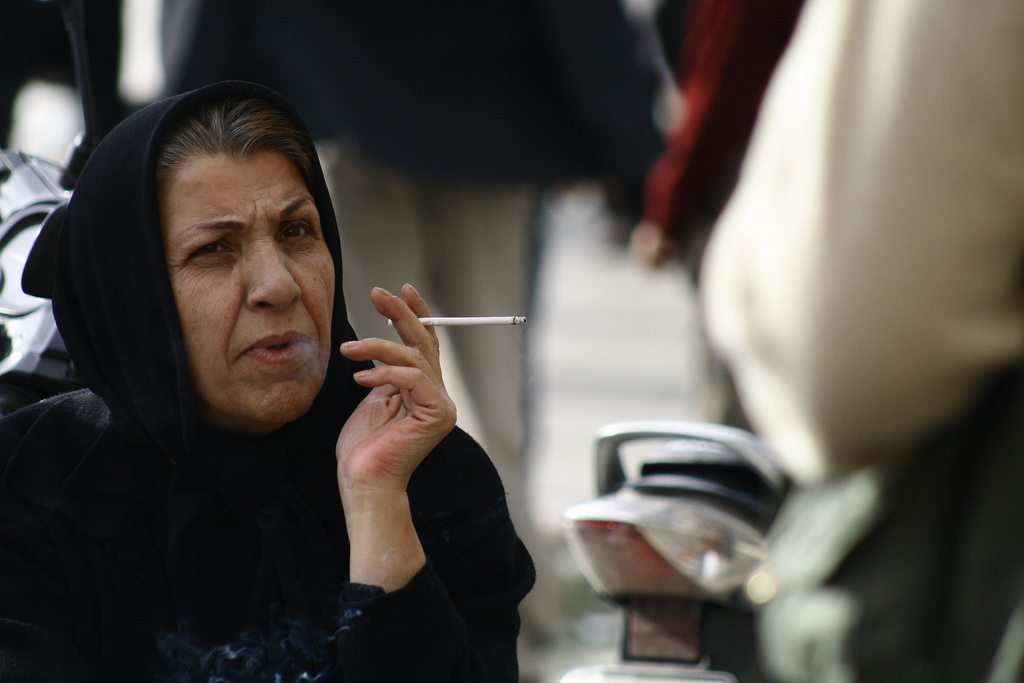The daughters of 1979
Lost stories from Iran

The restrictions of women’s freedoms and rights are much-known consequences of Iran’s 1979 revolution. But the Islamic redirection of the country had other effects as well. In the 1980s and 1990s, the country’s literacy rates jumped and the number of Iranian women enrolling in universities significantly increased.
Alex Shams, a Harvard MA student and co-editor-in-chief of Ajam Media Collective (and occasional Mashallah contributor), just finished his master’s thesis entitled Daughters of the Iranian Revolution: Women’s Experiences of Increased Access to Higher Education in the Islamic Republic, 1987–97. Mashallah News spoke to him about the personal stories that get lost in grand narratives.
Alex, tell us about your research. How did it start?
Growing up as part of the Iranian diaspora in USA, I was much affected by the dominant narrative of post-1979 Iran as an increasingly repressive, stagnant and women-hostile society. This narrative was seldom questioned or nuanced, neither by the US mainstream nor by most Iranians abroad. So I got interested in looking at that era from another perspective. As someone with a background in gender research, I wanted to find out what women’s lived experiences said about the interplay between Islam and women’s rights during that period.
A lot of work has been done on gender and the Iranian revolution, but it is mostly based on people who have left Iran. You can also see that much research has been influenced by Western media imagery. There is a pre-existing narrative that goes something like this: there was a revolution in 1979, it destroyed Iran and the country has been an awful place since then, especially for women. There is this idea that Iranian women before were totally free and all of them just spent their time at the beach, while they are now all in veils and oppressed.
“After 1979, a new trend emerged which suddenly said that it was Islamic to go to university.”
What about increased social restrictions and other things that impacted negatively on women’s lives?
Those who had lots of opportunities before the revolution — mainly the secular upper and upper middle classes — witnessed a contraction, especially in terms of social freedom, that’s for sure. But the majority of Iranians did not belong to this group. Even if the government prior to the revolution had not restricted women’s freedoms, families had. Most women experienced patriarchal control at the hands of their families. What I wanted to do in my research was to outline the reality for this big group of Iranian women, not that of the privileged minority which had been over-represented in previous research.
Interestingly, the rhetoric around things like family planning and education changed. Before the revolution, the public sphere was a secular space that many conservative families did not allow their women to access, often using religious language as justification. They thought of female higher education as un-Islamic But after 1979, a new trend emerged which suddenly said that it was Islamic to go to university. It was not only considered a right, but a religious duty. So, many girls and women began advocating for their rights to go, and increasingly were able to. With the religious clerics on their side, they could fight family-imposed restrictions.
I did not want to invalidate any such experiences, because there are women who lived through that, but it was apparent to me that it did not represent the entire situation. Such a linear model of history is rather confusing. The more I spoke to my own relatives and friends in Iran, the more I felt that this black-and-white story did not make sense because their experiences were not like that.
“In only one generation, families went from having seven kids on average to only two.”
When you started looking at that period, what did you find?
I looked at the years between 1987 and 1997. During that time, I found that opportunities for women in the country actually increased. The rates of employment, the kind of jobs that women took up — those figures pointed at an improved situation. The situation today is that women in Iran make up 65 percent of the higher education student body and female employment rates are higher than ever before in history. The increase began in the 1980s and 1990s when women of all classes and backgrounds began entering the public sphere en masse, in a way that had not happened before.
The average family size dropped following 1979. In only one generation, families went from having seven kids on average to only two. This was much the result of a highly effective government family planning program that distributed condoms for free and emphasised sex education instead of abstinence. Literacy rates improved too. Between 1980 and 1989, eight million Iranians learned to read and write, 70-80 percent of whom were women. There was a nation-wide call to eradicate illiteracy, which had tens of thousands of teachers go across the country and teach. The majority of both students and teachers were women.

“Teachers told me about how they set up their classes inside mosques, which meant that their legitimacy was not questioned.”
What women did you speak to during your research?
I interviewed different women who had experienced the years between 1987 and 1997. The oldest women I met had attended school before the revolution, when the educational system was secular, and the youngest women were schooled only under the post-1979 Islamic system. I spoke to women from different cities, both religious and secular. This was important, because there had been a bias earlier towards non-religious women.
Iran has a wealth of different ethnic and minority groups. Meeting women from different groups was interesting for me personally because my family is Persian, from the centre of Iran, an area which is not that diverse. I found myself discussing soap operas on a couple of occasions — it’s absolutely fascinating how you have Arab women following shows in Arabic, Azeri women watching Turkish series or soap operas from Azerbaijan, and yet others watching South Korean or Syrian shows.
I spoke to some of the teachers who went around the country during the literacy campaign. They told me about how they set up their classes inside mosques, which meant that their legitimacy was not questioned. Husbands could not tell their wives not to go to the mosque! This definitely contributed to the huge jump in literacy. There had been campaigns during the 1960s and 1970s, but these were top-down campaigns and completely ineffective. Teachers came from the cities to the countryside without any sense of connection to what life there was like. There are horror stories of teachers literally being kicked out of village schools.
You mentioned that the revolution changed what was considered socially and religiously acceptable?
Yes, very much. Imam Khomeini had a revolution in mind that was at the same time modern and Islamic. In his speeches, he urged women to stand alongside men during the protests. This is interesting because it represents one of the big contradictions of the revolution — while women were asked to obey conservative religious norms, they were also told to go out into the streets and make themselves heard. Essentially, the earlier social pressures which restricted women from entering the public realm began dissolving the moment that Khomeini told women to participate. All of a sudden, people listened to him instead of the family patriarch.
It is interesting to see how conservative ideals were often tackled and destabilised through the discourse of a different kind of revolutionary religiosity. Even as conservative religious ideas entered the government more than before, they actually became a tool for women to fight against patriarchal norms in the family. This domestic revolution was striking to me because it really changed things. The idea that “you can do anything you want within the norms of Islam” became predominant. Bear in mind that we’re not talking about any total, unrestricted freedoms, that was not the case of course. What became available to women was another kind of access, on new terms. Interestingly, this had much more of an impact on society than anything that the Shah did during his rule, because he had none of that legitimacy.
“Conservative ideals were often tackled and destabilised through the discourse of a different kind of revolutionary religiosity.”
Religion and modernity, constantly redefined. Sounds like a familiar debate.
Exactly. It reminded me very much of the debates I grew up around in the United States. I remember how my history schoolbooks as a kid said that USA is “One nation under God”. Many countries that are considered “modern” and “secular” still depend heavily on religious norms. Coming to terms with modernity and religion is something that all societies grapple with. Much of my research is also about questioning the secular bias that many feminists in the West have: the idea that the only way to be free is to be secular. Sure, secularism has been a great liberating force for many, but it has been limiting for some. Religion too has been a limiting force, but it has also been tremendously liberating for many.
“Even if 1979 had brought about many negative consequences, there had also been an awakening.”
So what conclusions did you reach after listening to all these stories?
I was even more convinced that one cannot understand Iran through a conventional prism. Looking at the country during that era, on the one hand you had these very real social and economical improvements, but on the other you had the obvious need for political reform. I think we are all aware of the bad consequences of 1979 — and these are very real — but not of the other part of the story. I grew up in the 1980s, which were very dark times because of the war [between Iraq and Iran] and never heard about any of the positive developments.
Towards the end of my interviews, when I explained why I wanted to hear their experiences, I mentioned the narrative prevailing in the West of Iranian women as oppressed. Many of the people I met did not recognise that image at all! To them, it ran contradictory to every one of their experiences. They remembered fighting and creating more opportunities for themselves during the last 30 years. Even if 1979 had brought about many negative consequences, there had also been an awakening — as a direct result of the revolution, not merely in spite of it. I think that’s why I found conducting these interviews so important: these are the stories that get lost in the grand narratives.
If you want further reading, Alex wrote this piece on the topic. He also recommends these books: Minoo Moallem’s Between Warrior Brother and Veiled Sister: Islamic Fundamentalism and the Politics of Patriarchy in Iran, Ziba Mir-Hosseini’s Islam and Gender: The Religious Debate in Contemporary Iran, Fariba Adelkhah’s Being Modern in Iran, Women, Power and Politics in 21st Century Iran and Veiled Employment: Islamism and the Political Economy of Women’s Employment in Iran. Both photos are CC courtesy of Mohammad Ali.








One thought on “The daughters of 1979”